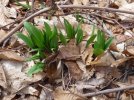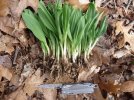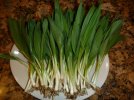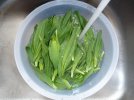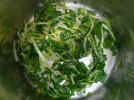- Joined
- Aug 7, 2009
- Messages
- 251
I have been foraging for a few years, but usually I have been too busy to do much in the spring. This year has been different and I recently found a large patch of ramps in an area I've only been to in summer and fall (the leaves die back in summer, you see), much to my delight. These were on a hillside in rich deciduous forest above a stream. The area also sports skunk cabbage and an understory made almost entirely of spicebush. Here is one of many clumps:

A good way to uproot plants like this is to take a straight, fairly thick stick and carve the end into a wedge shape. Push this down into the soil next to the plant, then push it under at an angle. Lift straight up to pull up the soil and intact plant- bulbs, roots, and all. This is what they look like uprooted.

Note the remnants of last year's bulb at the base. This is key to identifying the plant, as the closest lookalike, lily of the valley, doesn't have a bulb at any time. Crushing any part of the plant will yield a strong garlic-onion odor with a hint of something I can't quite put my finger on. This is perhaps even more important for identification than the bulb. No similar plant that smells like onion or garlic is poisonous, to the best of my knowledge. For convenience, I pulled apart the clumps and trimmed the roots on those that I took. I replanted the smallest ones (with roots intact) in the loose soil and patted it down so that in a few years, there will be a new clump to uproot. Ramps regenerate fairly slowly from what I've read- harvesting maybe 2-3% of a stand per year is considered sustainable while other species will tolerate harvesting much larger percentages. This is the day's haul:

To clean, rub loose the slimy gray remnants of the bulb and rinse to give something that looks rather more like their common name, wild leek. Later in the spring, a bulb develops which provides energy to flower in early summer and the following spring is entirely used up to make the first few leaves. After cleaning, the total weight was about 6oz.

Like regular leeks, ramps have a tendency to get filled with dirt. Trim off the root ends and cut the leaves off from the white part. Split the white part lengthwise and agitate in a change or two of water to get rid of trapped soil, which mostly sinks. Similarly agitate the leaves to clean.

Make sure to separate all of the leaves; dirt gets stuck most where they come together. Once clean, chop the leaves into ~1inch sections to break up any stringy fibers.
A good way to uproot plants like this is to take a straight, fairly thick stick and carve the end into a wedge shape. Push this down into the soil next to the plant, then push it under at an angle. Lift straight up to pull up the soil and intact plant- bulbs, roots, and all. This is what they look like uprooted.
Note the remnants of last year's bulb at the base. This is key to identifying the plant, as the closest lookalike, lily of the valley, doesn't have a bulb at any time. Crushing any part of the plant will yield a strong garlic-onion odor with a hint of something I can't quite put my finger on. This is perhaps even more important for identification than the bulb. No similar plant that smells like onion or garlic is poisonous, to the best of my knowledge. For convenience, I pulled apart the clumps and trimmed the roots on those that I took. I replanted the smallest ones (with roots intact) in the loose soil and patted it down so that in a few years, there will be a new clump to uproot. Ramps regenerate fairly slowly from what I've read- harvesting maybe 2-3% of a stand per year is considered sustainable while other species will tolerate harvesting much larger percentages. This is the day's haul:
To clean, rub loose the slimy gray remnants of the bulb and rinse to give something that looks rather more like their common name, wild leek. Later in the spring, a bulb develops which provides energy to flower in early summer and the following spring is entirely used up to make the first few leaves. After cleaning, the total weight was about 6oz.
Like regular leeks, ramps have a tendency to get filled with dirt. Trim off the root ends and cut the leaves off from the white part. Split the white part lengthwise and agitate in a change or two of water to get rid of trapped soil, which mostly sinks. Similarly agitate the leaves to clean.
Make sure to separate all of the leaves; dirt gets stuck most where they come together. Once clean, chop the leaves into ~1inch sections to break up any stringy fibers.


